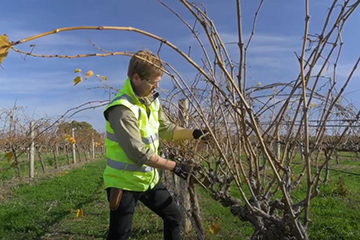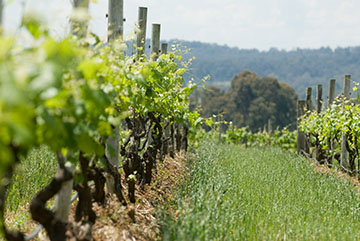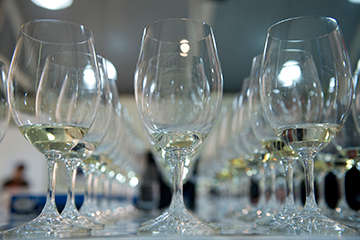Order the latest AWRI staff publications online
Accessing the latest AWRI publications is easy. Visit the AWRI Publications web page to:
- View the 10 most recent AWRI staff publications and order the articles online from the AWRI Library
- Search the staff publications database
- Read the full-text of ‘Technical Notes’ from Technical Review (PDF format)
- Read the full-text of ‘AWRI reports’ and ‘Vineyards of the world columns’ published in Wine & Viticulture Journal (PDF format)
- Read the full text of ‘Ask the AWRI columns’ published in Australian & New Zealand Grapegrower & Winemaker
The AWRI’s most recent publications are listed below.
2139 Gawel, R., Schulkin, A., Smith, P.A., Espinase, D., McRae, J.M. Effect of dissolved carbon dioxide on the sensory properties of still white and red wines. Aust. J. Grape Wine Res. 26(2): 172-179; 2020.
2140 Coulter, A. Ask the AWRI: Discrepancies in analytical results for volatile acidity. Aust. N.Z. Grapegrower Winemaker (674): p. 64; 2020.
2141 Roach, M.J., Borneman, A.R. New genome assemblies reveal patterns of domestication and adaption across Brettanomyces (Dekkera) species. BMC Genomics 21: 194; 2020.
2142 Mosinska, M., Stepińska, N., Maniukiewicz, W., Rogowski, J., Mierczynska-Vasilev, A., Vasilev, K., Szynkowska, M.I., Mierczynski, P. Hydrogen production on Cu-Ni catalysts via the oxy-steam reforming of methanol. Catalysts 10: 273; 2020.
2143 Verdonk, N., Ristic, R., Culbert, J., Pearce, K., Wilkinson, K. Understanding the Australian wine consumers’ preferences for different sparkling wine styles. Beverages 6: 14; 2020.
2144 Kontoudakis, N., Smith, M., Smith, P.A., Wilkes, E.N., Clark, A.C. The colorimetric determination of copper in wine: total copper. Aust. J. Grape Wine Res. 26(2): 121-129; 2020.
2145 Teng, B., Petrie, P., Smith, P.A., Bindon, K.A. Comparison of water addition and early-harvest strategies to decrease alcohol concentration in Vitis vinifera cv. Shiraz wine: impact on wine phenolics, tannin composition and colour properties. Aust. J. Grape Wine Res. 26(2): 158-171; 2020.
2146 Longbottom, M. Ask the AWRI: Promoting grapevine recovery after fire damage. Aust. N.Z. Grapegrower Winemaker (675): 66-67; 2020.
2147 Scrimgeour, N., Almond, T., Wilkes, E. Is KPA the magic bullet for tartrate instability in wines? Aust. N.Z. Grapegrower Winemaker (675): 68-70; 2020.
2148 Petrie, P.R., Jiang, W., Bindon, K.A., Sadras, V.O. When do grapes stop accumulating sugar? Beames, K.S., Robinson, E.M.C., Dry, P.R., Johnson, D.L. (eds.) Proceedings of the 17th Australian Wine Industry Technical Conference: Adelaide, South Australia, 21–24 July 2019. Urrbrae, S.A.; The Australian Wine Industry Technical Conference Inc.: 37–39; 2020.
2149 Culbert, J.A., Jiang, W., Krstic, M.P., Herderich, M.J. Evaluating activated carbons for removal of phenols and their glycosides from smoke-affected juice and wine. Beames, K.S., Robinson, E.M.C., Dry, P.R., Johnson, D.L. (eds.) Proceedings of the 17th Australian Wine Industry Technical Conference: Adelaide, South Australia, 21–24 July 2019. Urrbrae, S.A.; The Australian Wine Industry Technical Conference Inc.: 45–48; 2020.
2150 Bartel, C.E., Borneman, A.R., Curtin, C.D., Varela, C.A. Is Brettanomyces bruxellensis becoming more SO2 tolerant in industry? Beames, K.S., Robinson, E.M.C., Dry, P.R., Johnson, D.L. (eds.) Proceedings of the 17th Australian Wine Industry Technical Conference: Adelaide, South Australia, 21–24 July 2019. Urrbrae, S.A.; The Australian Wine Industry Technical Conference Inc.: 50–51; 2020.
2151 Sawyer, S., Longo, R., Solomon, M. Nicoletti, L. Westmore, H., Merry, A., Gnoinski, G., Ylia, A., Dambergs, R., Kerslake, F. Is it age or the autolysis? Pulling apart where sparkling wine character comes from. Beames, K.S., Robinson, E.M.C., Dry, P.R., Johnson, D.L. (eds.) Proceedings of the 17th Australian Wine Industry Technical Conference: Adelaide, South Australia, 21–24 July 2019. Urrbrae, S.A.; The Australian Wine Industry Technical Conference Inc.: 52–55; 2020.
2152 Pearson, W., Schmidtke, L., Francis, L., Li, S., Blackman, J., Carr, T. Understanding the role of regionality in Shiraz – sensory and chemical profiles of Shiraz wines from six different regions. Beames, K.S., Robinson, E.M.C., Dry, P.R., Johnson, D.L. (eds.) Proceedings of the 17th Australian Wine Industry Technical Conference: Adelaide, South Australia, 21–24 July 2019. Urrbrae, S.A.; The Australian Wine Industry Technical Conference Inc.: 75–77; 2020.
2153 Day, M.P., Capone, D.L., Kassara, S., Bilogrevic, E.O., Espinase Nandorfy, D., Watson, F.T., Francis, I.L., Bindon, K.A. Whole bunch fermentation of Shiraz and Pinot Noir: influence on ‘green’ characters and astringency. Beames, K.S., Robinson, E.M.C., Dry, P.R., Johnson, D.L. (eds.) Proceedings of the 17th Australian Wine Industry Technical Conference: Adelaide, South Australia, 21–24 July 2019. Urrbrae, S.A.; The Australian Wine Industry Technical Conference Inc.: 94–96; 2020.
2154 Bekker, M.Z., Espinase Nandorfy, D., Kulcsar, A.C., Faucon, A., Smith, P.A. Remediating ‘reductive’ characters in wine. Beames, K.S., Robinson, E.M.C., Dry, P.R., Johnson, D.L. (eds.) Proceedings of the 17th Australian Wine Industry Technical Conference: Adelaide, South Australia, 21–24 July 2019. Urrbrae, S.A.; The Australian Wine Industry Technical Conference Inc.: 97–99; 2020.
2155 Roach, M.J., Johnson, D.L., Bohlmann, J., van Vuuren, H.J.J., Jones, S.J.M., Pretorius, I.S., Schmidt, S.A., Borneman, A.R. Population sequencing reveals clonal diversity and ancestral inbreeding in the grapevine cultivar Chardonnay. Beames, K.S., Robinson, E.M.C., Dry, P.R., Johnson, D.L. (eds.) Proceedings of the 17th Australian Wine Industry Technical Conference: Adelaide, South Australia, 21–24 July 2019. Urrbrae, S.A.; The Australian Wine Industry Technical Conference Inc.: 111–114; 2020.
2156 Nordestgaard, S., Wilkes, E.N. Inspirations from the past and opportunities for the future. Beames, K.S., Robinson, E.M.C., Dry, P.R., Johnson, D.L. (eds.) Proceedings of the 17th Australian Wine Industry Technical Conference: Adelaide, South Australia, 21–24 July 2019. Urrbrae, S.A.; The Australian Wine Industry Technical Conference Inc.: 115–124; 2020.
2157 McRae, J.M. New techniques and technologies for wine protein stabilisation. Beames, K.S., Robinson, E.M.C., Dry, P.R., Johnson, D.L. (eds.) Proceedings of the 17th Australian Wine Industry Technical Conference: Adelaide, South Australia, 21–24 July 2019. Urrbrae, S.A.; The Australian Wine Industry Technical Conference Inc.: 125–126; 2020.
2158 Bindon, K.A., Teng, B., Smith, P.A., Espinase Nandorfy, D., Solomon, M., Petrie, P.R. Winemaking with high Baume juice: optimising fermentation and extraction. Beames, K.S., Robinson, E.M.C., Dry, P.R., Johnson, D.L. (eds.) Proceedings of the 17th Australian Wine Industry Technical Conference: Adelaide, South Australia, 21–24 July 2019. Urrbrae, S.A.; The Australian Wine Industry Technical Conference Inc.: 131–133; 2020.
2159 Delgado, L., Parker, M., Fisk, I., Paradisi, F. Performance of the extremophilic enzyme BglA in the hydrolysis of two aroma glucosides in a range of model and real wines and juices. Food Chem. 323: 126825; 2020.
2160 Scrimgeour, N., Hirlam, K., Bey, L., Wilkes, E. Extending the shelf life of canned wines. Aust. N.Z. Grapegrower Winemaker (674): 68-70; 2020.
2161 Carew, A.L., Kerslake, F.L., Bindon, K.A., Smith, P.A., Close, D.C., Dambergs, R.G. Viticultural and controlled phenolic release treatments affect phenolic concentration and tannin composition in Pinot noir wine. Am. J. Enol. Vitic. doi:10.5344/ajev.2020.19003: 1-29; 2020. |





